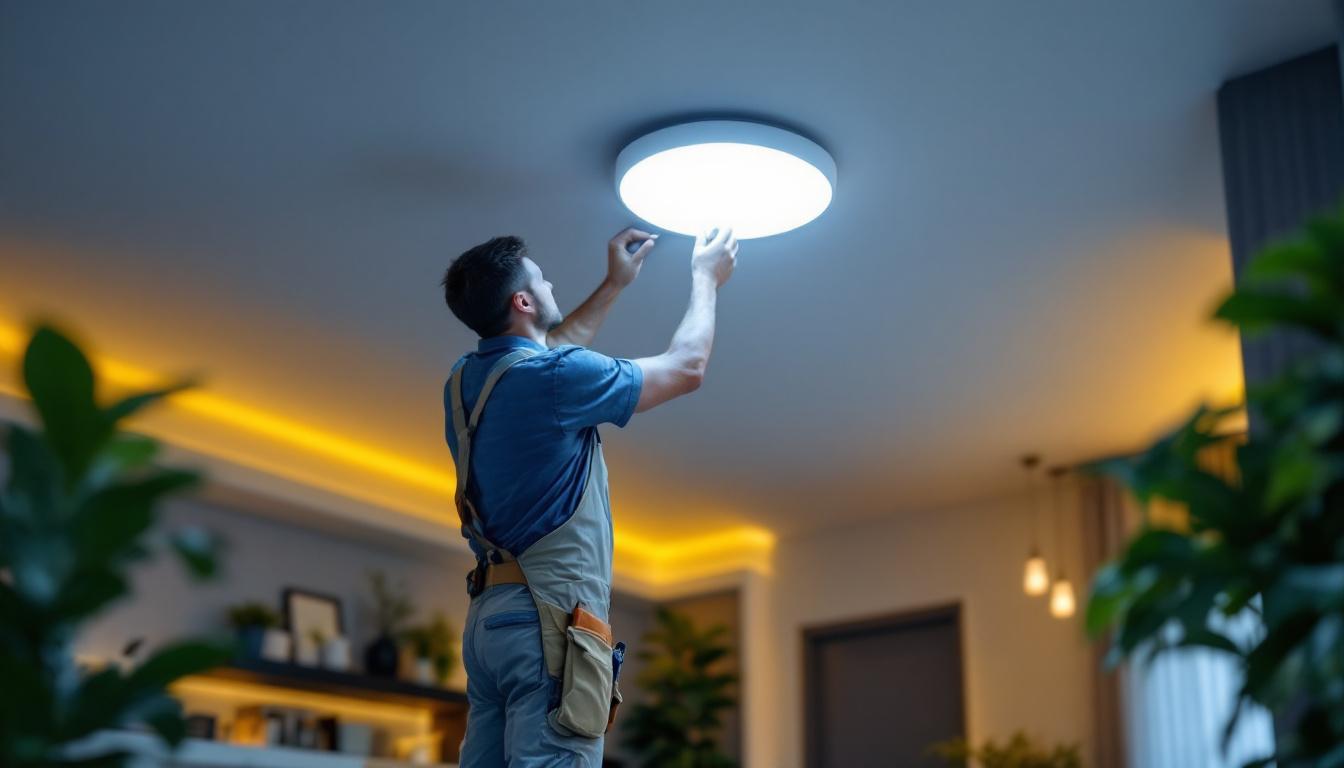
Lighting installation is a critical aspect of construction and renovation projects, and the process of cable pulling plays a significant role in ensuring that electrical systems function optimally. For lighting contractors, mastering this skill can be the difference between a successful project and a costly setback. This article delves into the essential elements that distinguish top lighting contractors in the realm of cable pulling, exploring best practices, tools, and techniques that elevate their work.
Cable pulling is not just a routine task; it is a fundamental part of the electrical installation process. Proper cable management ensures that lighting systems operate safely and efficiently. Inadequate cable pulling can lead to a host of issues, including electrical failures, safety hazards, and increased costs due to rework. Understanding the importance of this process is crucial for lighting contractors aiming to deliver high-quality results.
Moreover, the efficiency of cable pulling can significantly impact project timelines. When contractors are skilled at this task, they can complete installations more quickly, allowing for faster project turnover and increased client satisfaction. This efficiency can also lead to cost savings, making it a vital area of focus for any lighting contractor. A well-executed cable pulling process not only enhances the reliability of the lighting system but also contributes to a smoother workflow, reducing the likelihood of costly delays and ensuring that projects stay on schedule.
One of the first steps in effective cable pulling is understanding the different types of cables used in lighting installations. From low-voltage cables to high-voltage systems, each type has its own specifications and requirements. Knowledge of these differences allows contractors to select the appropriate cables for each project, ensuring compatibility with the lighting fixtures and the overall electrical system. For instance, low-voltage cables are often used in landscape lighting and accent lighting, while high-voltage cables are essential for overhead lighting and commercial applications.
Additionally, contractors must be aware of the National Electrical Code (NEC) guidelines that govern cable installation. Adhering to these regulations not only ensures safety but also protects the contractor from potential legal issues. By staying informed about cable types and specifications, top lighting contractors can execute their work with confidence and precision. Furthermore, understanding the environmental factors, such as temperature and moisture levels, can also influence cable selection, as certain materials may be better suited for specific conditions, thereby enhancing the longevity and performance of the lighting system.
Effective cable pulling begins long before the actual installation. Thorough planning and preparation are essential components that set top contractors apart. This includes assessing the project site, determining the optimal cable routes, and preparing the necessary tools and equipment. A comprehensive plan not only streamlines the installation process but also anticipates potential challenges that may arise during the project.
Contractors should conduct a detailed site survey to identify potential obstacles that could hinder the cable pulling process. This proactive approach allows for the development of a strategic plan that minimizes delays and complications during installation. Moreover, having the right tools on hand, such as cable pullers, lubricants, and fish tapes, can significantly enhance efficiency and effectiveness. Additionally, training team members on the best practices for cable pulling can further improve the process, ensuring that everyone is aligned and capable of executing their roles effectively. By investing time in planning and preparation, contractors can not only enhance their operational efficiency but also foster a culture of safety and excellence within their teams, ultimately leading to superior project outcomes.
Mastering the techniques of cable pulling is essential for lighting contractors who wish to excel in their field. Various methods can be employed to ensure that cables are pulled smoothly and without damage. Understanding these techniques can help contractors avoid common pitfalls and improve overall project outcomes.
The right tools can make a world of difference in the cable pulling process. High-quality cable pullers, for instance, are designed to handle the weight and resistance of the cables being pulled. This reduces the physical strain on workers and minimizes the risk of cable damage.
In addition to pullers, tools such as cable lubricants can facilitate smoother pulls, especially in tight spaces or when navigating bends. Contractors should invest in reliable equipment and regularly maintain their tools to ensure optimal performance during installations.
There are several techniques that can enhance the efficiency of cable pulling. One effective method is the “one-man pull,” which allows a single contractor to manage the entire process. This technique requires careful planning and the use of appropriate tools to ensure safety and efficiency.
Another technique involves the use of a “pulling eye” or “pulling grip,” which can secure the cable during the pulling process. This not only provides a firm grip but also helps distribute the pulling force evenly, reducing the risk of damage to the cable. By mastering these techniques, lighting contractors can streamline their operations and improve their overall performance.
Safety is paramount in any electrical installation, and cable pulling is no exception. Top lighting contractors prioritize safety protocols to protect themselves and their team members from potential hazards. Understanding and implementing safety measures can prevent accidents and ensure compliance with industry regulations.
Wearing appropriate personal protective equipment (PPE) is essential for any contractor involved in cable pulling. This includes hard hats, gloves, safety glasses, and steel-toed boots. By equipping themselves with the right PPE, contractors can minimize the risk of injury while working on-site.
Moreover, contractors should ensure that their team is trained in the proper use of PPE and understands the importance of maintaining a safe work environment. Regular safety meetings can reinforce these practices and keep safety at the forefront of everyone’s mind.
Before commencing any cable pulling operation, it is crucial to identify potential risks associated with the task. This includes assessing the work environment for hazards such as exposed wires, overhead obstructions, and uneven surfaces. By conducting a thorough risk assessment, contractors can implement strategies to mitigate these dangers.
Additionally, having a clear communication plan in place can enhance safety during the cable pulling process. Team members should be aware of their roles and responsibilities, and any changes in the work environment should be communicated promptly to avoid accidents.
Top lighting contractors understand that successful cable pulling is not solely about technical skills; it also involves building strong relationships with clients. Effective communication and transparency can enhance client satisfaction and lead to repeat business and referrals.
From the outset of a project, it is essential to set clear expectations with clients regarding timelines, costs, and the scope of work. By providing a detailed project plan and discussing potential challenges, contractors can foster trust and confidence in their abilities.
Regular updates throughout the project can also keep clients informed and engaged. This transparency not only helps manage expectations but also allows clients to feel involved in the process, ultimately leading to a more positive experience.
Quality workmanship is a hallmark of top lighting contractors. By consistently delivering high-quality results, contractors can build a reputation for excellence that attracts new clients and retains existing ones. This commitment to quality extends to every aspect of the cable pulling process, from planning and preparation to execution and follow-up.
In addition to meeting industry standards, contractors should strive to exceed client expectations. This can involve going the extra mile to ensure that installations are not only functional but also aesthetically pleasing. By prioritizing quality, contractors can differentiate themselves in a competitive market.
The lighting industry is constantly evolving, with new technologies and techniques emerging regularly. Top lighting contractors recognize the importance of continuous learning and adaptation to stay ahead of the curve. Embracing new developments can enhance skills and improve overall project outcomes.
Keeping abreast of industry trends is essential for contractors who wish to remain competitive. This can involve attending trade shows, participating in workshops, and subscribing to industry publications. By staying informed, contractors can gain insights into new tools, techniques, and best practices that can enhance their cable pulling processes.
Furthermore, engaging with professional networks and associations can provide valuable opportunities for knowledge sharing and collaboration. These connections can lead to new partnerships and business opportunities, ultimately benefiting contractors and their clients.
Investing in training and development is a key strategy for top lighting contractors. This can include formal training programs, on-the-job training, and mentorship opportunities. By fostering a culture of continuous improvement, contractors can equip their teams with the skills and knowledge necessary to excel in cable pulling and other aspects of electrical installation.
Moreover, encouraging team members to pursue certifications and additional qualifications can enhance the overall expertise of the organization. This commitment to professional development not only benefits the contractors but also instills confidence in clients, knowing that they are working with a knowledgeable and skilled team.
Cable pulling is a critical component of lighting installation that requires skill, planning, and attention to detail. Top lighting contractors distinguish themselves through their mastery of techniques, commitment to safety, and dedication to client satisfaction. By understanding the importance of cable pulling and implementing best practices, contractors can elevate their work and enhance their reputation in the industry.
As the lighting industry continues to evolve, embracing continuous learning and adaptation will be essential for contractors seeking to maintain their competitive edge. By prioritizing quality workmanship, effective communication, and ongoing professional development, lighting contractors can ensure their success in an ever-changing landscape.
Ready to take your lighting installations to the next level? LumenWholesale is here to support your commitment to excellence. With our extensive selection of spec-grade lighting products, you can ensure every cable pulling job is complemented by the highest quality fixtures. Say goodbye to inflated markups and hello to unbeatable wholesale prices, free shipping, and the convenience you deserve. Elevate your projects with reliable, high-performance lighting that meets the highest industry standards. Wholesale Lighting at the Best Value is just a click away. Partner with LumenWholesale today and experience the difference quality and value can make.

Discover how 5 inch LED recessed lighting boosts efficiency for lighting contractors with energy savings, easy installation, and cost-effective solutions.

Discover how low price grow lights are revolutionizing the lighting industry by making indoor gardening more accessible and sustainable.

Discover the top challenges lighting contractors face when working with 4ft fluorescent tubes.

Discover the essential role of foot candles in the lighting industry and learn how mastering this measurement can elevate your projects.